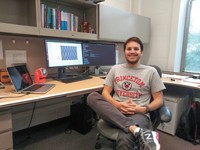Advertisement
Grab your lab coat. Let's get started
Welcome!
Welcome!
Create an account below to get 6 C&EN articles per month, receive newsletters and more - all free.
It seems this is your first time logging in online. Please enter the following information to continue.
As an ACS member you automatically get access to this site. All we need is few more details to create your reading experience.
Not you? Sign in with a different account.
Not you? Sign in with a different account.
ERROR 1
ERROR 1
ERROR 2
ERROR 2
ERROR 2
ERROR 2
ERROR 2
Password and Confirm password must match.
If you have an ACS member number, please enter it here so we can link this account to your membership. (optional)
ERROR 2
ACS values your privacy. By submitting your information, you are gaining access to C&EN and subscribing to our weekly newsletter. We use the information you provide to make your reading experience better, and we will never sell your data to third party members.
Careers
A Purposeful Break
Recharge your life and your career with a sabbatical
by Linda Wang
September 8, 2008
| A version of this story appeared in
Volume 86, Issue 36

THIS FALL, as students return to the classroom feeling recharged, many professors return feeling anything but. For them, summers can be just as busy as the regular school year.
So naturally, when the opportunity to go on a sabbatical arises, many professors won't pass it up. "I'm religious about taking sabbaticals," says Edward T. Samulski, a professor of chemistry at the University of North Carolina, Chapel Hill, who has done five sabbaticals in five different countries over a period of 36 years. "As a faculty member, you're writing grants and papers and going to committee meetings. It's those distractions that you don't have while you're on sabbatical," he says.
A sabbatical frees up academics from their normal teaching, research, and administrative responsibilities so they can focus on an area of personal or professional growth. "Sabbaticals are an opportunity to explore new directions or to shore up the direction you're going in with new techniques and new things that you learn," says Susan Jackels, a chemistry professor at Seattle University who has done four sabbaticals, two of them in Nicaragua.
Many chemistry departments allow their faculty to take a sabbatical after seven years of service and every seven years thereafter. Sabbaticals typically last six months to a year and are often fully or partially funded by the university, depending on the length of leave.

Preparing for a sabbatical can be a lot of work, but those who have done them say the experience is well worth it. Samulski credits each of his sabbaticals with broadening his perception of chemistry. "You begin to see that there are other ways of looking at the science you're interested in and other ways of attacking a problem," he says.
Mary Virginia Orna, a senior scientist in residence at the College of New Rochelle, in New York, says her sabbaticals strengthened her skills as a teacher. While on sabbatical at the National Institute of Environmental Health Sciences, in Research Triangle Park, N.C., Orna gained experience in writing grant proposals.
When she returned to the college, she thought it would be educational to have her lab course students write grant proposals instead of lab reports. In their proposals, students had to justify, for example, why they needed to purchase a particular instrument to do their experiment. Orna says the exercise got her students thinking about chemistry from a different angle.
Lynn A. Melton, a chemistry professor at the University of Texas, Dallas, used his time away to gain experience working in industry. He worked at United Technologies Research Center in East Hartford, Conn., from 1981 to 1982, and then at Dow Chemical in Freeport, Texas, from 1998 to 1999.
Melton says the experiences benefited both him and his students. "I wanted to perk up my research program, but I also wanted to go out and see the environment that I would be placing my students into," he says, noting that a majority of Ph.D. graduates end up working for industry. Through his new connections, he was also able to secure positions both at United Technologies and at Dow for a number of his students. In addition, the connections helped him gain more funding for his research projects.
Some academics have used their sabbaticals to learn how the federal government works. Samulski's most recent sabbatical was as a science adviser at the Department of State. He says that during his time as a Jefferson Science Fellow, he began to understand how science shapes policy and was able to bring that experience back to his students. "It now enables me to tell my graduate students that there are career opportunities for scientists that are not directly in science," Samulski says.
OCCASIONALLY, a sabbatical can completely change the course of a person's career. Orna spent the earlier part of her career doing research on chelates. In 1978, she was asked to develop a chemistry course for art majors. Orna admits that at the time she knew virtually nothing about art. She learned of a sabbatical opportunity at New York University's Institute of Fine Arts Conservation Center and began a yearlong collaboration with art historians there to examine art preservation from a chemical standpoint.
Orna fell in love with the work, and after she returned she not only developed the new chemistry course but shifted her research to using chemistry to preserve art and other artifacts. "I went off in a totally different direction and never went back to looking at chelates again," she says. "But that's all right. That's where I felt I should be."
Like Orna, Seattle University's Jackels completely changed her research focus after returning from a sabbatical in Nicaragua. She started her career studying transition-metal complexes. While attending an international conference, Jackels learned about the plight of Nicaraguan coffee farmers affected by the global coffee crisis, caused by oversupply as more nations began exporting coffee beans, sometimes of low quality, which sent coffee prices plummeting. The crisis was exacerbated by an increase in "defective" coffee beans entering the market; defective beans could be underripe and sour, fermented, or moldy, for example.
Jackels decided to go to Nicaragua to find out whether she could use her expertise in chemistry to help the coffee farmers there. She spoke no Spanish and had never done any fieldwork. But she returned to Seattle feeling excited because "it had clicked. There was a place for me," she says. It turns out that during the fermentation process, the coffee beans were spoiling, which compromised the quality of the final product.
Several years and several return visits later, Jackels found a way to prevent the spoilage from happening and published a paper on her findings (J. Food Sci. 2005, 70, C321). "Their coffee quality improved enough that they're able to sell it on the specialty market" at a higher price than they could before, she says.
Professors at community colleges say sabbaticals are critical for providing much-needed time and resources to do research. "Most community colleges don't have the facilities where you can carry out any kind of research," says David Katz, a chemistry professor at Pima Community College, in Tucson, Ariz., who did two sabbaticals, one of which he used to complete a research project. "Our labs are generally in constant use, and you really don't have any private space to do things. If you want to get involved with some form of research or advanced work, you need to do a sabbatical."

A sabbatical can be an educational experience for the entire family. Frances H. Arnold, a professor of chemical engineering and biochemistry at California Institute of Technology, took her husband and three boys with her on a sabbatical in Africa and Australia. When she was not doing research or giving talks, Arnold and her family would travel to different countries. Some of their adventures included visiting aborigines in Australia, Bushmen in Namibia, and various cultural groups in Madagascar. "We tend to become very narrow in our thinking, and I decided that I wanted to expand my childrens' brains and my own brain at the same time," she says. "I wanted to make it as rich for my family as possible."
Jackels also found a way to include her family in her sabbatical experience. She convinced her husband, Charles, a computational chemist at the University of Washington, Bothell, to take his sabbaticals at the same time, and they went to Nicaragua together. Susan handled the experimental aspects of the research, and Charles did statistical analysis of the data. In the end, Charles also shifted his research to focus on coffee quality. He had previously been doing quantum chemical calculations on molecules related to atmospheric pollution. Susan and Charles's daughter visited them in Nicaragua for several weeks, and the experience made such an impression on her that she later pursued a degree in international law.
Although some professors worry about leaving their research group for an extended period of time, others look at a sabbatical as a growth opportunity. Arnold says her students thrived while she was away. "By leaving for six months, I saw who could grow into the role of being mentors and submitting their own papers and handling all the little things of the job," she says. "It was actually a beneficial learning experience for them."
Because sabbatical opportunities are rarely advertised, the best way to get a sabbatical is by making connections. If you meet someone at a scientific meeting who is doing research related to yours, find out whether an opportunity exists to collaborate. And once you get your first sabbatical, it's not uncommon for that to lead to other sabbatical opportunities.
But for all their benefits, sabbaticals also have a downside. They can be especially hard on a small chemistry department. "At a small institution, we have to hire temporary faculty, and that's a big question mark," says Daniel McLoughlin, chair of the chemistry department at Xavier University, in Cincinnati, who has gone on two sabbaticals. "You never know exactly what you're getting," he adds.
But McLoughlin says the benefits that come from a good experience far outweigh any inconveniences to a department. "I would always fight for having our faculty be able to have sabbaticals so that they can grow, and therefore our students can grow. And then the university grows because of that," he says. "If it means that we have some temporary setbacks, so be it." He recommends that any professor going on sabbatical give the department a year's notice so it can find a temporary replacement.
Whether going on a first sabbatical or a fifth, a person should remember to keep an open mind. "I often went on a sabbatical naively thinking that I was going to accomplish A, B, and C, and in fact, I ended up working on G, which at the time looked totally irrelevant," Samulski says. "Then, a couple of years later, I would see that this directly impacted, in a curious way, the science that I was doing."
In the end, a sabbatical can simply provide inspiration. "People get so involved in their teaching that they're no longer thinking creatively as a chemist anymore," McLoughlin says. "The creativity is still there, it just needs to be sparked again." And going on a sabbatical might be all it takes to produce a spark.
Education Supplement
- Introduction: Communities Of Practice
- This year's education supplement looks at green chemistry curricula.
- The Ivory Tower Goes Green
- Green chemistry is transforming the curriculum.
- Web Exclusive: Green Education
- Online Green Chemistry Resources
- Rocky Mountain Green
- News from the sixth annual ACS Summer School on Sustainability & Green Chemistry.
- Staying Alive
- A cadre of scientists is trying to revitalize the nuclear and radiochemistry fields.
- Small-Scale Chemistry
- Primarily undergraduate institutions provide students with a quality chemistry education.
- A Purposeful Break
- Recharge your academic career—and your life—with a sabbatical.





Join the conversation
Contact the reporter
Submit a Letter to the Editor for publication
Engage with us on Twitter